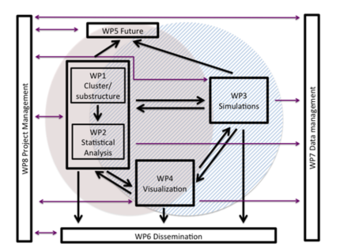We have structured this project into eight work packages. Four of these are scientific, one is linked to the final validated software to be produced, one deals with data management and curation, one with dissemination and communications and finally one with the overall management of the project. These are structured in such a way that the scientific links between the nodes are highlighted.
 WP1 and WP2 are based around the analysis of substructure and statistical measures of clustering (with the comparison of gas and stellar dynamics being split between both of these and the tools created by WP4). The analysis is carried out on both the models and observational data, and will be the responsibility of both theoretical and observational members of the team. This synergy has been common in the field of cosmology for over two decades, with considerable success, but is still rare in star formation (and is something Lumsden has experience of doing). In particular, the interaction between observation and theory is crucial to ensure the best techniques that can be applied at all stages of the evolution of the cluster are consistent. WP1 and WP2 can start immediately since the work is already initiated at Grenoble based on the development, or adaptation of data mining and statistical tools, which can be applied to existing data in the first instance.
WP1 and WP2 are based around the analysis of substructure and statistical measures of clustering (with the comparison of gas and stellar dynamics being split between both of these and the tools created by WP4). The analysis is carried out on both the models and observational data, and will be the responsibility of both theoretical and observational members of the team. This synergy has been common in the field of cosmology for over two decades, with considerable success, but is still rare in star formation (and is something Lumsden has experience of doing). In particular, the interaction between observation and theory is crucial to ensure the best techniques that can be applied at all stages of the evolution of the cluster are consistent. WP1 and WP2 can start immediately since the work is already initiated at Grenoble based on the development, or adaptation of data mining and statistical tools, which can be applied to existing data in the first instance.
WP3 will deliver the suite of computer simulations of young massive clusters.WP3 will also start immediately since we require the outputs from this WP to fully test the techniques developed in WP 1 and WP2. Indeed we envisage the same personnel creating the models will be involved in the applications of the statistical methods.
WP4 will produce the key final data tools that we will deliver in a properly documented, standards compliant fashion. It also starts at project kick-off since the project will require properly documented and VO compliant software. The Software Quality Assurance Plan together with the definition of the data requirements will be developed in collaboration with those working on WP1-3. In particular, we wish to ensure that the simulation data can be stored, retrieved and analysed using the same tools as the observational data.
WP5 will deal with any new observations required to derive the properties of the more heavily embedded clusters. The observations will be informed by the early work of WP1 and WP2, as well as the results from analysing the simulations, and therefore this WP starts later than the others. It is likely that it will combine a mixture of radial velocities derived from infrared spectroscopy, large scale gas mapping in the mm/sub-mm as well as more detailed gas kinematics from suitable interferometric facilities (ALMA, PdBI).
WP6 deals with all dissemination and communications activities outlined in section 2.2, including organisation of team meetings, a terminal international conference, publication strategy, public outreach and the user experience of the web portal we will create. This will start at project kick-off, in a small scale, and ramp up over the course of the first year to the full plan given.
WP7 deals with data management, including its long term curation. This starts at kick-off given the imperative to create a Data Management Plan (and updates) as the core milestone that drives this WP.
Finally WP8 will deal with all management issues with regard to the successful outcome of this project, including overall legal and financial matters. WP8 also formalises the structure of the Management Group and its relation to the overall legal authorities.
A list of deliverables for the project can be viewed here.
